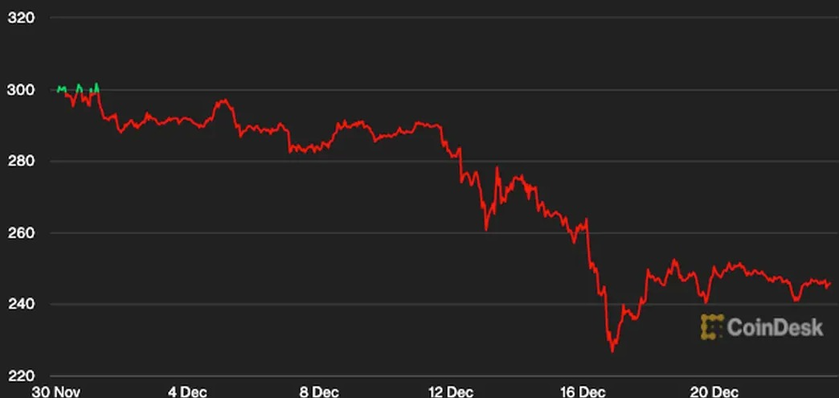The BNB token, with a market cap around $40 billion, has failed to win a listing on major U.S. crypto exchanges – except on Binance.US. Crypto analysts say it might be due to risks that BNB could be deemed a security by U.S. regulators.

Binance, the world’s biggest crypto exchange by trading volume, has been the focus of crypto-market speculation in recent weeks after blockchain watchers detected billions of dollars of deposit outflows, the company’s auditor begged off and reports emerged the company might be under investigation by U.S. authorities.
Such anxieties are clearly reflected in the recent downward trajectory for Binance’s in-house token, BNB: The price has tumbled about 17% this month to $245, vastly underperforming the broad CoinDesk Market Index of digital assets, which is down 5.7%. At the peak in May 2021, BNB changed hands at $690, according to data from CoinMarketCap. The token’s market capitalization has dropped to around $40 billion, from a record $116 billion at one point last year.
At the core of the concerns is whether Binance might be prone to a loss of confidence similar to November’s stunningly swift unraveling of Sam Bankman-Fried’s FTX exchange. And it’s impossible to ignore that the first signs of deep distress at FTX emerged when that exchange’s own FTT token started to plunge.
So as crypto analysts home in on BNB token’s valuation, they’re scrutinizing the FTT token’s arc for any red – or yellow – flags that, in hindsight, might have tipped investors off to the market’s fragility. And a key similarity stands out: Just as FTX’s FTT token had mostly failed to get listed on major U.S. crypto exchanges, so is BNB absent from a large number of U.S. exchanges. (It is listed on Binance.US.)
Some crypto analysts speculate that major U.S. exchanges might have steered clear of a BNB listing for fear of running afoul of regulators. Any issues on the regulatory front could also represent a risk for holders of the token.
“Exchanges probably do not list BNB as they see it as a security given the centralization of their network,” said Lucas Outumuro, head of research at IntoTheBlock, in an interview with CoinDesk. “It's probably not worth U.S. exchanges risking listing a security especially if it's a competitor's token.”
FTT gets designated as a security
The risk was underscored this week when the U.S. Securities and Exchange Commission labeled FTX’s FTT token as a security in a complaint.
The document pointed to the existence of FTT's "buy-and-burn" program as an example of how the token might be intended to serve as an investment. Such programs might be compared to a stock buyback, where companies redeem their own shares from the open market to reduce the outstanding supply and thus to increase their value.
Binance also offers a burn program, introduced in late 2021, labeled “BNB Burn,” and detailed on its website and updated as recently as Oct. 13.
“BNB is a deflationary currency, which means that it maintains a stable value through burning its tokens throughout the year,” the website reads.
According to Sean Farrell, head of digital asset strategy at Fundstrat, BNB is likely not listed on most domestic exchanges due to the fact it could be “deemed a security by regulators.”
CoinDesk asked Binance for a comment on the lack of BNB token listings on major U.S. exchanges besides Binance.US, and also if executives at the firm were worried that it might be deemed a security. No response was received as of press time. In an earlier communication, the representative noted that BNB was listed on several major crypto exchanges outside the U.S.
What the exchanges say
According to Binance's website, "BNB is the cryptocurrency coin that powers the BNB Chain ecosystem."
"As one of the world's most popular utility tokens, not only can you trade BNB like any other cryptocurrency, you can also use BNB in a wide range of applications and use cases," the website reads.
In terms of utility of the token, BNB can be used "to pay for goods and services, settle transaction fees on Binance Smart Chain, participate in exclusive token sales and more," according to the site. A yellow button at the bottom of the web page reads, "Buy BNB Now." Clicking that leads to another web page where a user can log in to Binance or sign up for an account.
According to CoinGecko, the digital-asset markets pricing site, BNB is listed on tens of crypto exchanges, including KuCoin, Huobi and OKX.
The U.S. exchange Kraken lists over 120 tokens but does not offer BNB to its customers.
A Kraken spokesperson said to CoinDesk that “Kraken is an agnostic player in the crypto market” and that it “has a robust asset selection and listing procedure that ensures assets receive the analysis and vetting they deserve, which includes a rigorous compliance, legal and security process.”
A representative for Coinbase, which also has not listed BNB, told CoinDesk, "If we haven’t listed a popular asset yet, it is likely due to various reasons which may include: We have concluded that the asset does not meet our listing standards, we do not have enough information about the asset, additional technical integration work is required, or we do not support the network for the given token standard.”
“BNB certainly is not in a position of strength, which will likely continue as thorny questions regarding Binance remain,” wrote Collin Howe, derivatives trader at B2C2 in a Friday note.





























